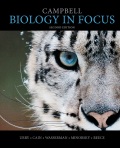
Concept explainers
Which of the following biomes is correctly paired with the description of its climate?
- A. savanna–low temperature, precipitation uniform during the year
- B. tundra–long summers, mild winters
- C. temperate broad leaf forest–relatively short growing season, mild winters
- D. tropical forests–nearly constant day length and temperature
Introduction:
A community of animals and plants with common characteristics for their environment is called a biome. It includes the likes of tropical forests, savannas, tundra and so on.
Answer to Problem 1TYU
Correct answer:
The tropical forests are near the equator, so their temperature is constantly warm and the day lengths are constant too. Therefore, option (D) is correct.
Explanation of Solution
Reason for the correct statement:
The region near the equator is always warm and the day length constant throughout the year as the sun moves almost perpendicular to the horizon all along the year.
Option (D) is given as “tropical forests-nearly constant day length and temperature”.
“Tropical forests-nearly constant day length and temperature is the biome which is correctly paired with the description of its climate”, it is the right answer.
Hence, option (D) is correct.
Reasons for the incorrect statements:
Option (A) is given as “savanna-low temperature, precipitation uniform during the year”.
Savannas are a mix of woodland and grassland ecosystems. They don’t have low temperatures and neither do they have uniform rain during the year. So, it is a wrong answer.
Option (B) is given as “tundra-long summers, mild winters”.
Tundra regions are very cold throughout the year and don’t have long summers. So, it is a wrong answer.
Option (C) is given as “temperate broadleaf forest-relatively short growing season, mild winters”.
Temperate broadleaf forests have cold winters. So, it is a wrong answer.
Hence, options (A), (B) and (C) are incorrect.
Tropical forests have constant temperature and day length throughout the year as they are near the equator.
Want to see more full solutions like this?
Chapter 40 Solutions
EBK CAMPBELL BIOLOGY IN FOCUS
Additional Science Textbook Solutions
Microbiology Fundamentals: A Clinical Approach
Laboratory Manual For Human Anatomy & Physiology
SEELEY'S ANATOMY+PHYSIOLOGY
Genetics: From Genes to Genomes
Human Physiology: An Integrated Approach (8th Edition)
- AaBbCc X AaBbCc individuals are crossed. What is the probability of their offspring having a genotype AABBCC?arrow_forwardcircle a nucleotide in the imagearrow_forward"One of the symmetry breaking events in mouse gastrulation requires the amplification of Nodal on the side of the embryo opposite to the Anterior Visceral Endoderm (AVE). Describe one way by which Nodal gets amplified in this region." My understanding of this is that there are a few ways nodal is amplified though I'm not sure if this is specifically occurs on the opposite side of the AVE. 1. pronodal cleaved by protease -> active nodal 2. Nodal -> BMP4 -> Wnt-> nodal 3. Nodal-> Nodal, Fox1 binding site 4. BMP4 on outside-> nodal Are all of these occuring opposite to AVE?arrow_forward
- If four babies are born on a given day What is the chance all four will be girls? Use genetics lawsarrow_forwardExplain each punnet square results (genotypes and probabilities)arrow_forwardGive the terminal regression line equation and R or R2 value: Give the x axis (name and units, if any) of the terminal line: Give the y axis (name and units, if any) of the terminal line: Give the first residual regression line equation and R or R2 value: Give the x axis (name and units, if any) of the first residual line : Give the y axis (name and units, if any) of the first residual line: Give the second residual regression line equation and R or R2 value: Give the x axis (name and units, if any) of the second residual line: Give the y axis (name and units, if any) of the second residual line: a) B1 Solution b) B2 c)hybrid rate constant (λ1) d)hybrid rate constant (λ2) e) ka f) t1/2,absorb g) t1/2, dist h) t1/2, elim i)apparent central compartment volume (V1,app) j) total AUC (short cut method) k) apparent volume of distribution based on AUC (VAUC,app) l)apparent clearance (CLapp) m) absolute bioavailability of oral route (need AUCiv…arrow_forward
- You inject morpholino oligonucleotides that inhibit the translation of follistatin, chordin, and noggin (FCN) at the 1 cell stage of a frog embryo. What is the effect on neurulation in the resulting embryo? Propose an experiment that would rescue an embryo injected with FCN morpholinos.arrow_forwardParticipants will be asked to create a meme regarding a topic relevant to the department of Geography, Geomatics, and Environmental Studies. Prompt: Using an online art style of your choice, please make a meme related to the study of Geography, Environment, or Geomatics.arrow_forwardPlekhg5 functions in bottle cell formation, and Shroom3 functions in neural plate closure, yet the phenotype of injecting mRNA of each into the animal pole of a fertilized egg is very similar. What is the phenotype, and why is the phenotype so similar? Is the phenotype going to be that there is a disruption of the formation of the neural tube for both of these because bottle cell formation is necessary for the neural plate to fold in forming the neural tube and Shroom3 is further needed to close the neural plate? So since both Plekhg5 and Shroom3 are used in forming the neural tube, injecting the mRNA will just lead to neural tube deformity?arrow_forward
 Concepts of BiologyBiologyISBN:9781938168116Author:Samantha Fowler, Rebecca Roush, James WisePublisher:OpenStax College
Concepts of BiologyBiologyISBN:9781938168116Author:Samantha Fowler, Rebecca Roush, James WisePublisher:OpenStax College Biology (MindTap Course List)BiologyISBN:9781337392938Author:Eldra Solomon, Charles Martin, Diana W. Martin, Linda R. BergPublisher:Cengage Learning
Biology (MindTap Course List)BiologyISBN:9781337392938Author:Eldra Solomon, Charles Martin, Diana W. Martin, Linda R. BergPublisher:Cengage Learning
 Biology 2eBiologyISBN:9781947172517Author:Matthew Douglas, Jung Choi, Mary Ann ClarkPublisher:OpenStax
Biology 2eBiologyISBN:9781947172517Author:Matthew Douglas, Jung Choi, Mary Ann ClarkPublisher:OpenStax Human Biology (MindTap Course List)BiologyISBN:9781305112100Author:Cecie Starr, Beverly McMillanPublisher:Cengage Learning
Human Biology (MindTap Course List)BiologyISBN:9781305112100Author:Cecie Starr, Beverly McMillanPublisher:Cengage Learning Biology Today and Tomorrow without Physiology (Mi...BiologyISBN:9781305117396Author:Cecie Starr, Christine Evers, Lisa StarrPublisher:Cengage Learning
Biology Today and Tomorrow without Physiology (Mi...BiologyISBN:9781305117396Author:Cecie Starr, Christine Evers, Lisa StarrPublisher:Cengage Learning





